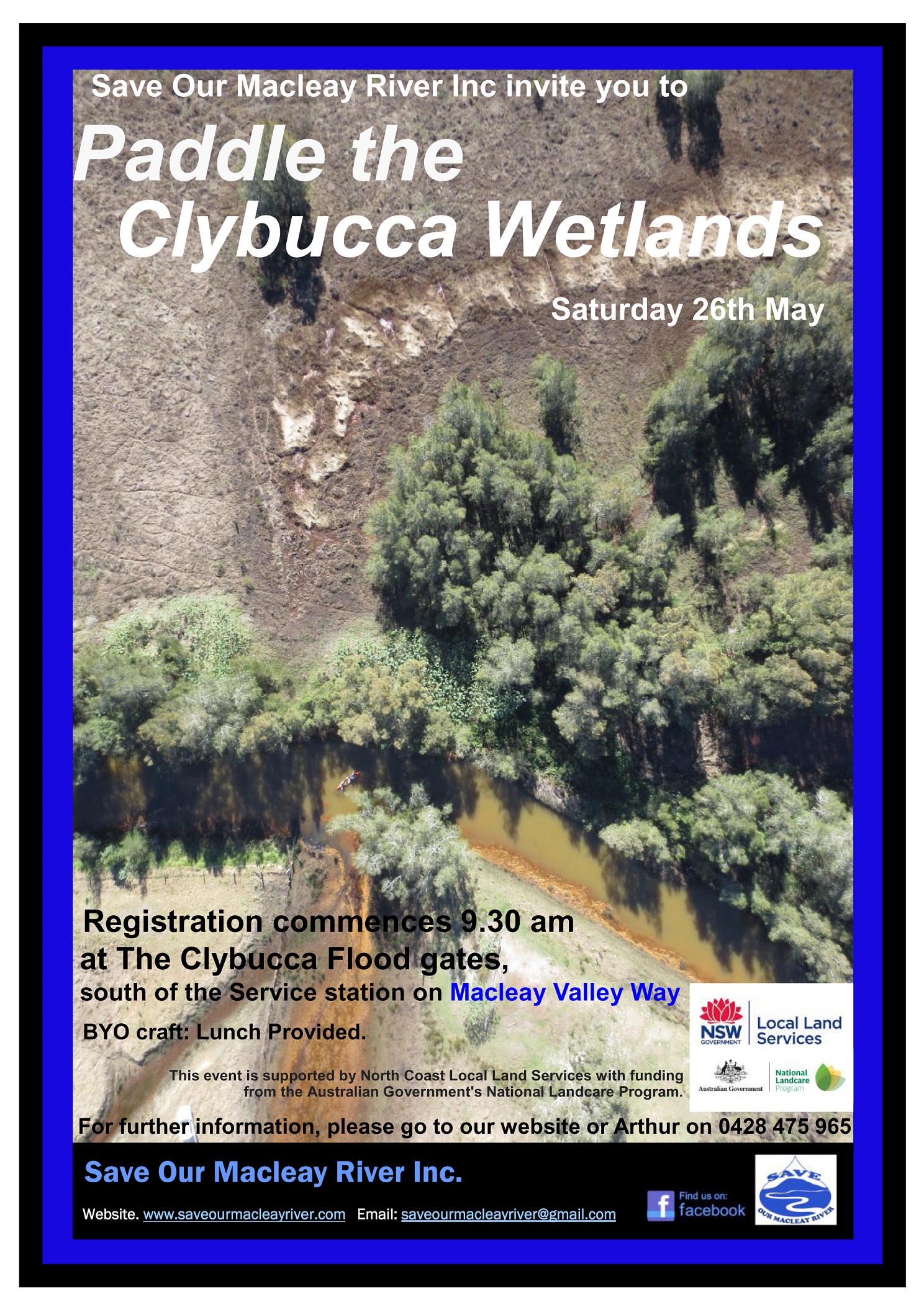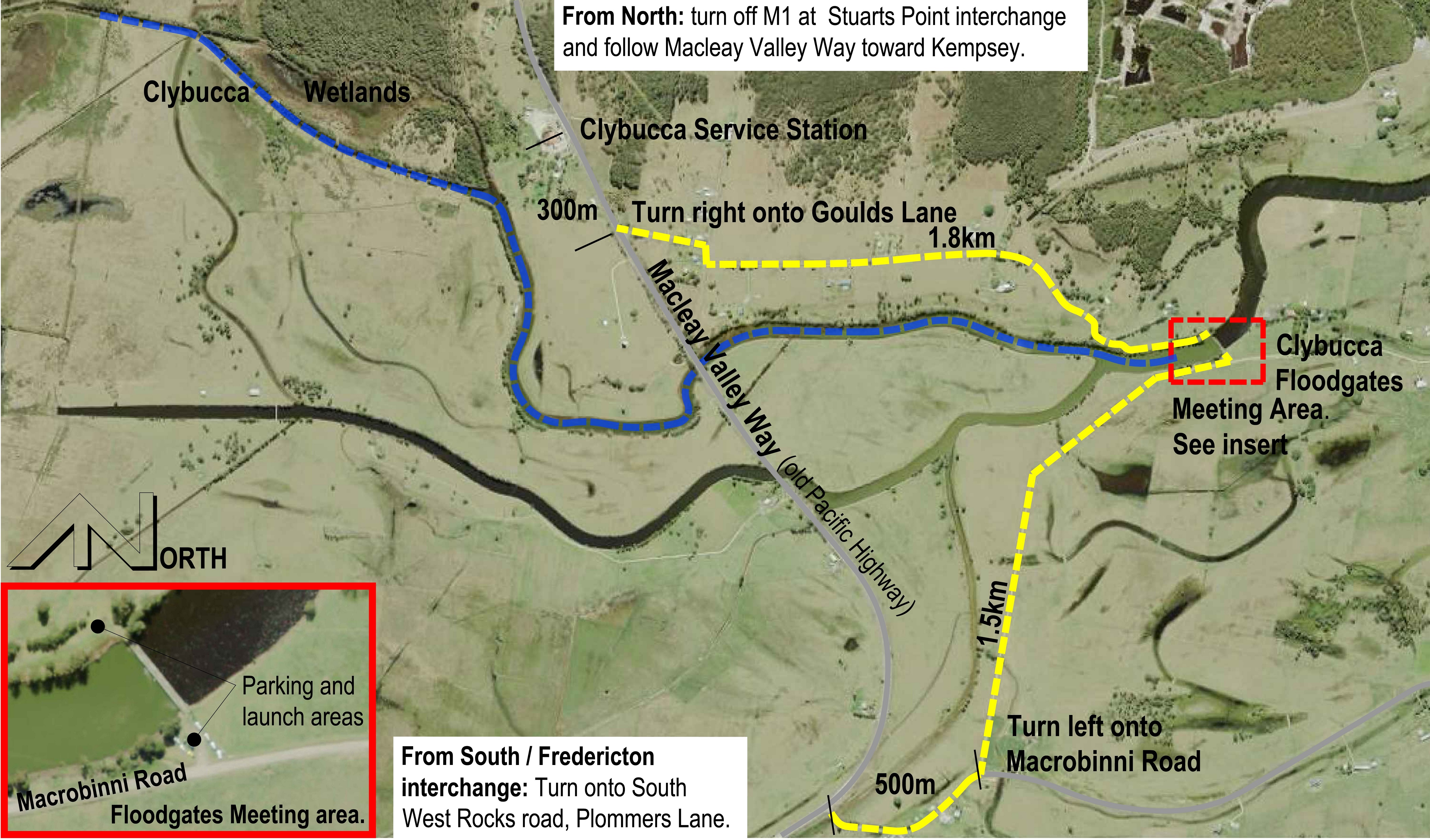The last couple of weeks in May brought a flurry of activities. First, a long expected meeting of numerous agencies concerned with the health of the Macleay River, then the Clybucca Wetlands Paddle.
Click here for a full report of the meeting. Macleay River Working Group 24th May 2018
What to Do on the Clybucca?
At an event hosted by SOMR and sponsored by North Coast Local Land Services, 55 paddlers went up the Clybucca Creek System on 26th May to explore and be informed of the environmental problems and a range of potential solutions.
A research and community engagement project is currently being undertaken on the Clybucca Floodplain, following a successful funding application for $365,000 under the NSW Department of Primary Industries (DPI) Flagship Fish Habitat Grants Program. The project, submitted by North Coast Local Land Services (LLS), will deliver a remediation strategy, complete with engineering design options to improve water management across the floodplain.
It will aim to neutralise acidic conditions across a large area of Mayes and Doughboy Swamps, improve freshwater wetland condition, and rehabilitate estuarine habitat. It will also aim to improve the drainage of productive grazing land throughout the Clybucca – Collombatti floodplain.
North Coast Local Land Services – Senior Land Services Officer Max Osborne said a key component of the project is community engagement. The Water Research Laboratory at the University of New South Wales (UNSW-WRL) has been engaged to prepare the strategy and the aim is to ensure all stakeholders’ concerns are addressed.
“Over the next 12 months, North Coast Local Land Services and UNSW-WRL will be working closely with landholders on the Clybucca floodplain, Seven Oaks Drainage Union, Kempsey Shire Council, NSW Government agencies, community groups, the Aboriginal community, industry, and academics to ensure we get the best outcomes for the region,” he said.
What’s the problem?
Over drainage of coastal wetlands has created problems with acid sulfate soils, causing sulfuric acid runoff; and has also increased the frequency and magnitude of “blackwater” events, depleting oxygen in the creeks and river after flooding. This has unfortunately had wider impacts on the estuary, including the loss of fish habitat and impacts to aquatic life, such as fish and oysters in the Lower Macleay. This impacts the environment, the local economy, recreational and commercial fishing, traditional usage and tourism.
What caused this problem?
The Clybucca sub-catchment has undergone hydrological change over time. At one time, it was covered by the sea and had slowly filled in by the sediment eroding from the upper Macleay catchment. In the late 19th century the area was a freshwater wetland. However, the marine mud (high in sulfur) lay below the wetlands sediment.
Tidal restricting barriers, flood gates and extensive drainage networks have lowered surface and groundwater levels and exposed the marine muds (naturally occurring acid sulphate soils) to oxygen—resulting in the acidification of topsoil, groundwater, in-drain water and ultimately, the Macleay estuary. (Osborne 2018)
Over-drainage has allowed flood-intolerant grass species to dominate where previously only wetland-adapted species thrived. During floods, these grasses are inundated for several days. They die and rot—depleting the floodwater of oxygen. This hypoxic (no oxygen) blackwater then drains into the Macleay estuary, which damages the aquatic ecosystem. (Osborne 2018) Over-drainage has allowed flood-intolerant grass species to dominate where previously only wetland-adapted species thrived. During floods, these grasses are inundated for several days. They die and rot—depleting the floodwater of oxygen. This hypoxic (no oxygen) blackwater then drains into the Macleay estuary, which damages the aquatic ecosystem. (Osborne 2018)
Russell Yerbury, a former beef producer from the Clybucca Floodplain and Max Osborne from North Coast Local Land Services discussed the issues and some of the potential solutions being investigated as part of the remediation strategy project.
SOMR would like to thank Max and Russell for their commitment to improving the health of the Macleay, and for supporting the Clybucca Wetlands Paddle. We would also like to thank the participants in the paddle and encourage community to be informed and participate in this crucial decision impacting the future health of the Macleay River.
Wetlands Australia 2018 https://www.environment.gov.au/system/files/resources/b0f30409-2d92-4ec6-a57d-35e59b765be0/files/wa30-full.pdf Pg. 35 – 36 relate to the Clybucca Wetlands
Blackwater Fact Sheet http://www.environment.gov.au/system/files/resources/c6a83595-14ef-4d82-8db3-0aec0a172b64/files/cewo-blackwater-factsheet.pdf
Wetland Pasture https://www.dpi.nsw.gov.au/__data/assets/pdf_file/0003/405696/Water-couch-growth-and-productivity.pdf
Click here for a video created by Elsinor Photography showing the Paddle. https://www.youtube.com/watch?v=RoOsH7G3koY


